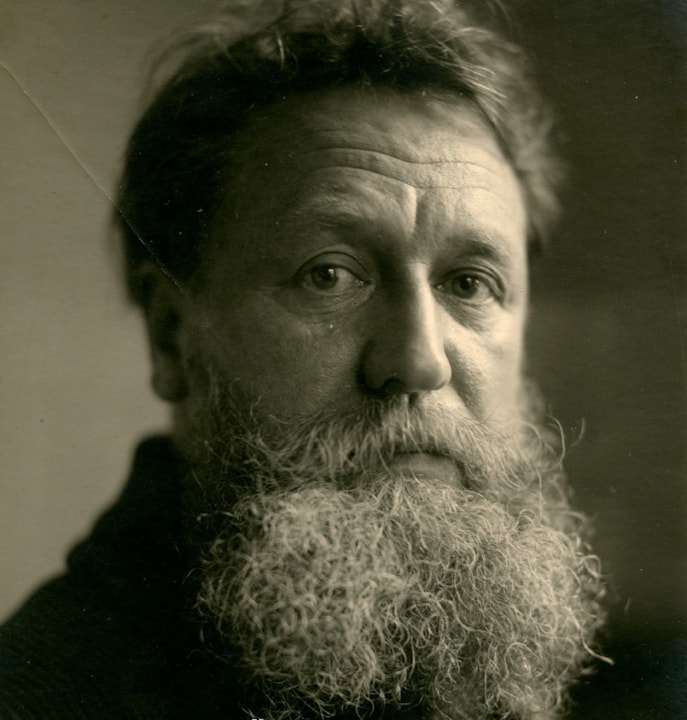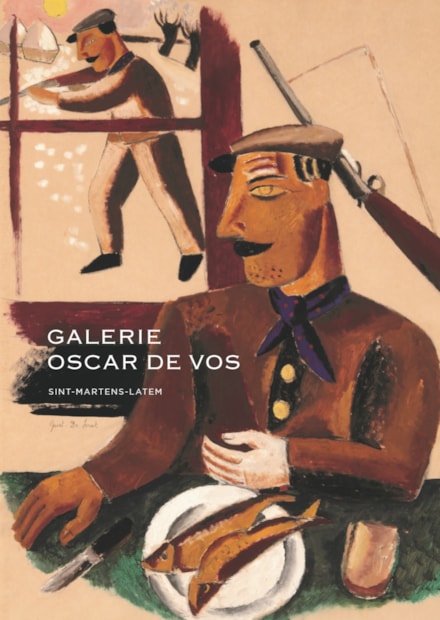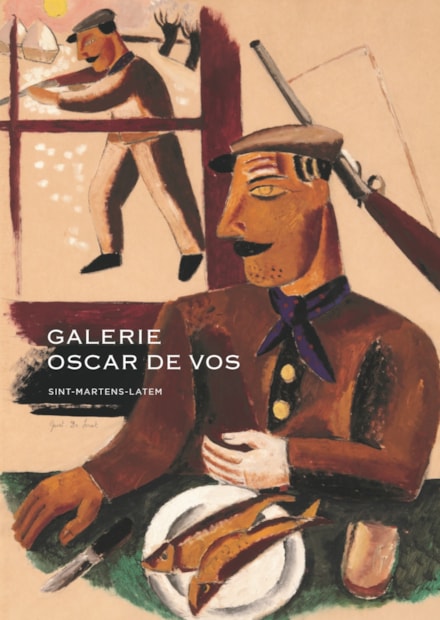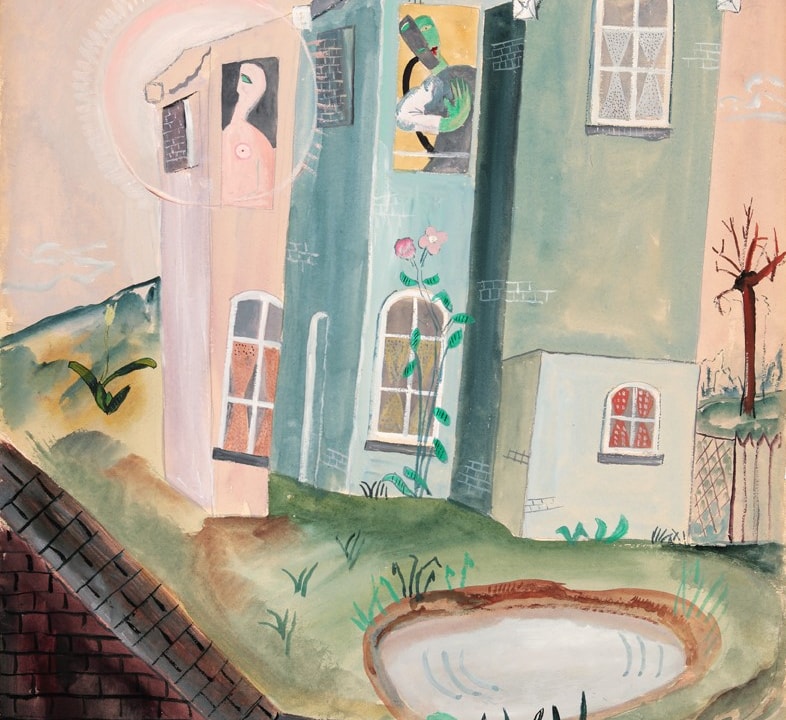Albert Servaes
(1883 - 1966)

Albert Servaes
(1883 - 1966)
Rond 1899 verkende Albert Servaes de streek rond Sint-Martens-Latem. Op dat ogenblik was de zestienjarige handelsreiziger in kruidenierwaren nauwelijks met zijn vak bezig; liever plantte hij zijn chevalet in het bevallige landschap.
In 1904 zou hij zich voor een lange periode in het dorp vestigen. Op de Brakel trok hij in een huisje in dat hij met Frits Van den Berghe deelde. In Latem ging de atheïstische Servaes zich plots voor het religieuze interesseren. Het fanatisme van de bekeerling deed de verstandhouding met de rabiaat ongelovige Van den Berghe snel verloren gaan. Ten langen leste trok hij bij Doorke Malfait in. Aan het schamele huis van het keuterboertje bouwde hij prompt een atelier aan. Pas in dit eenvoudige milieu vond Servaes zijn streng. Rond 1908 ontmoette de kunstenaar pater Jeroom, de karmeliet die Servaes’ spirituele leven zou sturen. De hang naar mystiek werd aangezwengeld; het religieuze fanatisme overwon.
De kunstenaar die tijdens de vooroorlogse jaren nauwelijks van zijn schilderkunst kon leven, kende tijdens de Eerste Wereldoorlog een groot succes. Hij kreeg een aantal individuele tentoonstellingen in het Gentse. Het succes was dermate groot dat hij plannen maakte voor een monumentale woning inclusief atelier in Sint-Martens-Latem. In 1918 betrok hij dit huis dat hij ‘Torenhuis’ doopte.
Met de clerus stond Servaes evenwel op gespannen voet. In 1918 ontwierp hij in opdracht van pater Jeroom een kruisweg voor een nieuw te bouwen kloosterkapel in Luithagen. De ruwe, onbehouwen vormentaal die aan El Greco herinnerde, shockeerde de goegemeente en deed een fikse rel ontstaan in rooms-katholieke middens. Te midden de hetze werd hij door de avant-gardistische galerie Sélection voor een individuele tentoonstelling uitgenodigd; in 1921 zou Sélections evenknie Le Centaure dit voorbeeld volgen. Ook Pater Jeroom bleef zijn discipel verdedigen. Nog in 1921 organiseerde hij een rondreizende tentoonstelling van de kruisweg van Luithagen in Nederland. In hetzelfde jaar ontmoette Servaes zijn Franse geestesgenoot Georges Rouault te Parijs.
Ook in de latere jaren 1920 bleef Servaes in beeld in de Brusselse avant-gardistische kringen. Samen met George Minne exposeerde hij in november 1926 in de galerie Le Centaure. Anderzijds groeide ook zijn buitenlandse faam. In augustus 1929 organiseerde het Amsterdamse Stedelijk Museum een tentoonstelling van zijn recente werk; het museum zou het volgende jaar de reeks monnikenbeeltenissen aankopen. Servaes’ werk bleef in de jaren 1930 populair in Nederland. Maar ook in eigen land bleef er belangstelling voor zijn werk. De openingstentoonstelling van de nieuwe galerij Ars te Gent was volledig aan zijn werk gewijd. Anderzijds kreeg hij ook steun uit Franse katholieke zijde. Op bezoek in Latem was de dichter Paul Claudel diep onder de indruk van Servaes werk.
In 1931 trok Servaes regelmatig naar Italië, waar hij de kerken en musea van Milaan, Padua, Ravenna, Verona en Venetië bezocht. In de nadagen van de Tweede Wereldoorlog werd Servaes door anonieme dreigementen op de vlucht gedreven. Langs Duitsland om belandde hij uiteindelijk in Zwitserland. De kunstenaar zou op 83-jarige leeftijd in ballingschap overlijden.
In 1904 zou hij zich voor een lange periode in het dorp vestigen. Op de Brakel trok hij in een huisje in dat hij met Frits Van den Berghe deelde. In Latem ging de atheïstische Servaes zich plots voor het religieuze interesseren. Het fanatisme van de bekeerling deed de verstandhouding met de rabiaat ongelovige Van den Berghe snel verloren gaan. Ten langen leste trok hij bij Doorke Malfait in. Aan het schamele huis van het keuterboertje bouwde hij prompt een atelier aan. Pas in dit eenvoudige milieu vond Servaes zijn streng. Rond 1908 ontmoette de kunstenaar pater Jeroom, de karmeliet die Servaes’ spirituele leven zou sturen. De hang naar mystiek werd aangezwengeld; het religieuze fanatisme overwon.
De kunstenaar die tijdens de vooroorlogse jaren nauwelijks van zijn schilderkunst kon leven, kende tijdens de Eerste Wereldoorlog een groot succes. Hij kreeg een aantal individuele tentoonstellingen in het Gentse. Het succes was dermate groot dat hij plannen maakte voor een monumentale woning inclusief atelier in Sint-Martens-Latem. In 1918 betrok hij dit huis dat hij ‘Torenhuis’ doopte.
Met de clerus stond Servaes evenwel op gespannen voet. In 1918 ontwierp hij in opdracht van pater Jeroom een kruisweg voor een nieuw te bouwen kloosterkapel in Luithagen. De ruwe, onbehouwen vormentaal die aan El Greco herinnerde, shockeerde de goegemeente en deed een fikse rel ontstaan in rooms-katholieke middens. Te midden de hetze werd hij door de avant-gardistische galerie Sélection voor een individuele tentoonstelling uitgenodigd; in 1921 zou Sélections evenknie Le Centaure dit voorbeeld volgen. Ook Pater Jeroom bleef zijn discipel verdedigen. Nog in 1921 organiseerde hij een rondreizende tentoonstelling van de kruisweg van Luithagen in Nederland. In hetzelfde jaar ontmoette Servaes zijn Franse geestesgenoot Georges Rouault te Parijs.
Ook in de latere jaren 1920 bleef Servaes in beeld in de Brusselse avant-gardistische kringen. Samen met George Minne exposeerde hij in november 1926 in de galerie Le Centaure. Anderzijds groeide ook zijn buitenlandse faam. In augustus 1929 organiseerde het Amsterdamse Stedelijk Museum een tentoonstelling van zijn recente werk; het museum zou het volgende jaar de reeks monnikenbeeltenissen aankopen. Servaes’ werk bleef in de jaren 1930 populair in Nederland. Maar ook in eigen land bleef er belangstelling voor zijn werk. De openingstentoonstelling van de nieuwe galerij Ars te Gent was volledig aan zijn werk gewijd. Anderzijds kreeg hij ook steun uit Franse katholieke zijde. Op bezoek in Latem was de dichter Paul Claudel diep onder de indruk van Servaes werk.
In 1931 trok Servaes regelmatig naar Italië, waar hij de kerken en musea van Milaan, Padua, Ravenna, Verona en Venetië bezocht. In de nadagen van de Tweede Wereldoorlog werd Servaes door anonieme dreigementen op de vlucht gedreven. Langs Duitsland om belandde hij uiteindelijk in Zwitserland. De kunstenaar zou op 83-jarige leeftijd in ballingschap overlijden.
publicaties
BRAFA 2020 (French Version)







